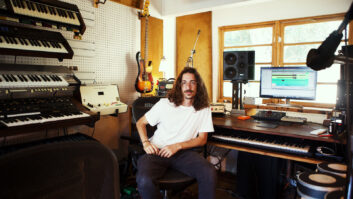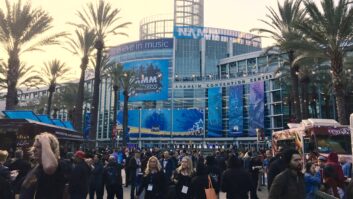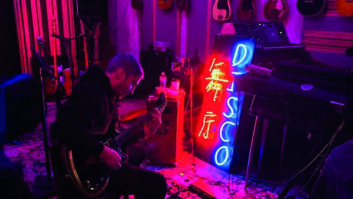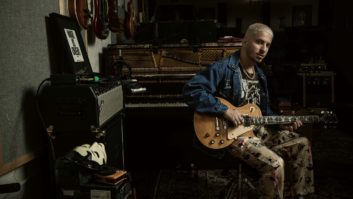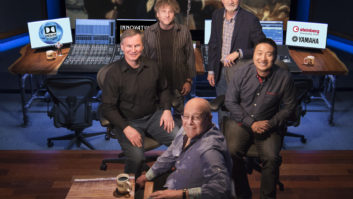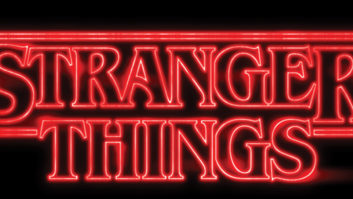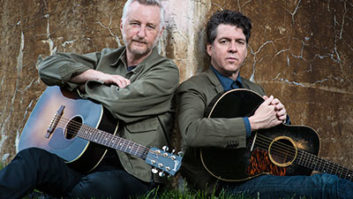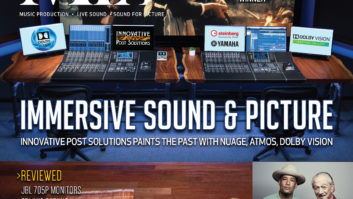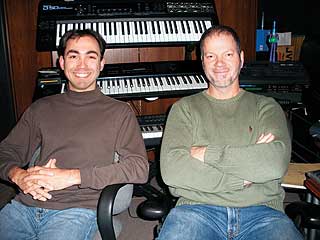
Director James Bartling, left, and author/composer Arlan Boll in Boll’s composition studio
As an advocate of newness in sound and film, I am constantly looking for art that has no repetitive boundaries. We are bombarded today with the same old thing. There are pointless film remakes and sequels, CDs that are mastered at 0db by default, and the total abuse of Auto-Tune software on vocals, which will date most music created in 2009. My feeling is that we should mix things up and seek creativity that challenges our being.
In an article I wrote for Mix a few years ago (“Surreal Sound, Toy Cameras,” January 2002, available at mixonline.com), I told the story of using the sound from a toy camera to score a film titled Killer Me. A director happened to see this film (I’ll admit, it wasn’t easy to find), and he was interested in having the score of his own movie be completely different than what he saw as “the norm.” I’m glad he called.
As a film composer, I have always had the idea of creating an entire vocal score, just to see if it could be done. Finding someone who would be willing to fund me to do so, and put that in his or her film, was the proverbial needle in a haystack. James Bartling from Twilight Child Productions Corp., the director of Nostalgia, had seen Killer Me and asked later if there was anything I had ever wanted to do differently regarding the scoring of a film. When I told him about the vocal score, he was apprehensive to say the least, but after several conversations, we agreed to move forward.
Nostalgia is a very different sort of film in that the dialog was recorded beforehand with a micro-recorder and put directly into the non-fiction script. Everyone from the movie’s events plays themselves, and many of the actual locations were used in re-creating particular moments in time as specifically as possible after the fact. Bartling has told me more than once that “Nostalgia is a movie about human connections,” so it made sense to extend that theme to the score. Musically speaking, it doesn’t get any more human than the larynx.
As we all know, music can certainly change the viewers’ experience of a film. But if you bring human voice as the only musical instrument, it can have both an enormous impact and introduce countless challenges. I now know why nobody scores film in this manner — because it’s harder than hell to do.
Hundreds of individuals contributed vocally to the Nostalgia score. The vocalists and compositions are from numerous ethnic backgrounds; the genres range from classical to tribal. The recording of the music involved everything from one-take solos to quarter-second edits. Some pieces practically wrote themselves. Others were painstaking to assemble. I know it’s a cliché, but you really have to hear it.
One piece in particular, titled “For You,” was composed for the end credits, and it is the culmination of the soundtrack album. Because lyrics tend to fight with dialog in film, this is one of the only pieces that has lyrics in its composition. “For You” comprised about 40 vocalists, with 128 tracks total in a Pro Tools Mix Plus session. Because I run a recording studio [AB Audio Visual], I have many vocal clients. “For You” included a country-western artist, an opera singer, a gospel vocalist and a crooner, to name a few. There was also Susaye Greene, an ex-Supreme.
Most Pro Tools users are familiar with Beat Detective, which sees transients in the music file and cuts before the transient. For example, if you had a file of a bongo hitting 10 times, you would have 10 cuts. If you put a vocal line through Beat Detective, it sees the consonants and cuts there. I used this to define notes in the lyrical lines of “For You.” I took one line from one client and one line from another until I had a potpourri of different voices. Then, within Beat Detective, I got a potpourri of vocal notes times a thousand.
With those notes, I was able to create patterns and harmonies, layer upon layer, until I had a full canvas of new music. In some ways, it wrote itself: There is a lead instrumentation bridge in which vocals are reversed and panned left and right. In the verses of the song, there are layers of notes. The menagerie of the piece as a whole is very hypnotic. The only effect used was reverb. Nothing else was necessary because the voices themselves were the effects.
Not all pieces of the album were constructed in this manner. “Batra Dreams” was actually composed as an emulation of the Harmonium, an Indian instrument. The Nostalgia title theme, written with the director, was actually made-up phrases, or scat, sung as its own language. There’s an 80-year-old vocalist who sings an antiquated hymnal and a gentleman born in Tanzania who used a verbal click-y language called Xhosa in another piece. In the song “Roy and Mo (O and D Dance),” I took the initiative of simulating George Martin’s approach to the calliope at the end of the song “For the Benefit of Mr. Kite,” where he took the magnetic tape of the recording of the calliope, cut it up with scissors, put the pieces of tape in a hat and pulled them out one by one, then Scotch-taped them back together. If you notice at the end of this song, the calliope has some jarring edits, but it still works within the song’s framework. In the same way, we had a female vocalist sing lines out of a phone book, and we subsequently chopped them up, put them in a digital hat, shook them around and arranged them as they fell out. The variety of musical pieces makes this album one of a kind, and I believe it’s worth a listen.
Nostalgia‘s 42-minute vocal soundtrack debuted in December as a digital download, released through Tunecore to all major online digital outlets. Director Bartling feels strongly that no individual tracks should be sold separately. “Arlan and I are not enamored with singles,” he says. “I much prefer experiencing the total journey from A to B. We want the album experienced in the way it was originally intended and constructed, and give the consumer the best value for their dollar. At the same time, we realize that in the end we have to leave people to their own devices. It’s ultimately up to you how you listen, or if you choose to listen at all. Whoever takes the journey will be rewarded.”
Indie Filmmaking Today
[Editor’s Note: Ever since Nostalgia director James Bartling finished his film, he has been trying to sell it in today’s climate, with little help. We asked him to share some of the “business” side of today’s filmmaking experience.]
When asked about my profession, I explain that I’m a dork from Long Beach who happens to have a privilege of falling in love with ideas. I’ve spent 13 years making a truly independent movie, Nostalgia, and have worn many different hats, most recently as a distributor. I have no bigwig Hollywood ties. My family has risked a second mortgage against our house for funding, and we’ve come a hair’s breadth from foreclosure. I’ve been ripped off tens of thousands of dollars, and to date I haven’t earned a penny. Through it all, I have truly maintained my love of art, its processes and its people.
Traversing the entertainment world is an intimidating and potentially frightening prospect. Can the creative side reconcile with the business end? How can I constructively survive in this industry when it can appear more likely to meet someone who cares more about their own personal gain rather than one who wants to develop a meaningful collaborative working relationship?
Becoming a distributor grew out of necessity. Nostalgia was screened for larger distributors in early 2009, and of the roughly dozen invited, only one attended. I was turned down. The struggling economy played a role, I was told. No one wanted to take a risk, no matter how conservative, and they still don’t today. So how do I deliver Nostalgia to the theatrical market and make the economy work for me?
I do my research and get on the phone. From the beginning, Nostalgia was intended for the theater; it was shot and mixed that way. My instincts told me that distribution through any other market first would mean the kiss of death, so that narrowed my focus. When speaking with theater circuits, a key point of my pitch is drawing an untapped audience who do not normally attend. I include myself in that grouping. Hollywood as a business looks at the bottom line: money. At the end of the day, my product has to sell itself.
On a practical level, I’m responsible for the completion and delivery of the physical product, all related promotional materials and a marketing plan of attack that can all simultaneously execute during the course of an entire year, depending on how the movie is rolled out geographically. I don’t have the space here for a detailed essay outline, but let’s say you’re a distributor and a theater circuit that has 20 theaters in one state takes you on. Just because those theaters are available doesn’t mean you’re going to open in all of them at once. The circuit will most likely select three theaters in specific cities to start, based on the economic knowledge of the population that has the most history of supporting your film’s genre. After a few weeks, if business does well, one or more of those prints may be shipped to other theaters throughout the state, continuing the cycle. Knowing this going in, you save money at the outset, freeing up funds for other needs and opening up the opportunity to make enough in sales to pay back into itself if the need arises. When and where a movie is first released is referred to as its “first run.” It is not uncommon for a movie to have a 32nd run. Nostalgia‘s opening run is tentatively slated for March of 2010. It is no accident that its soundtrack is released first to kick off the marketing campaign. Composer Arlan Boll and myself are hoping that interest in the music will carry over to the movie, given that each is strikingly original in its own way, and we will be updating this journey on Nostalgia‘s Website (www.nostalgia-movie.com), which launches in January.
A remarkable offer for angel funding came in June, from a source who attended the first screening. This offer included paying for prints and advertising, although none of those funds have yet been made available. So for the conceivable future, I’m still going it alone, with only my wits about me. It’s a rather exciting prospect to bring an independent production to fruition in a completely independent way.
One of Nostalgia‘s main themes is “connections,” and that applies perfectly to my role as a distributor. I’m just one man, without a car, without a cell phone, sitting in a small room, using a single land line, making a sincere human connection with the person on the receiving end. Along with having a product you believe in — created from real sweat, blood and tears — this connection is what’s most important; it’s what it takes.
